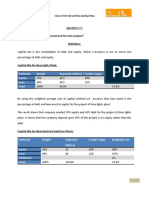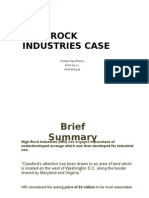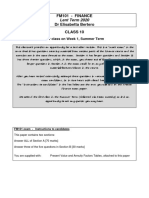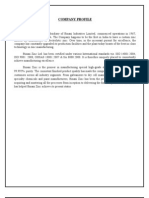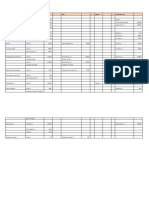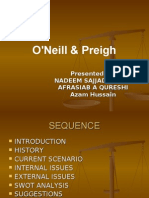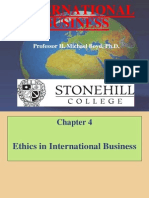Subject Title: C2A: Life Insurance
Subject Title: C2A: Life Insurance
Uploaded by
Jeff GundyCopyright:
Available Formats
Subject Title: C2A: Life Insurance
Subject Title: C2A: Life Insurance
Uploaded by
Jeff GundyOriginal Title
Copyright
Available Formats
Share this document
Did you find this document useful?
Is this content inappropriate?
Copyright:
Available Formats
Subject Title: C2A: Life Insurance
Subject Title: C2A: Life Insurance
Uploaded by
Jeff GundyCopyright:
Available Formats
2011 PART III EXAMINATIONS
Subject Title: C2A
Life Insurance
Date: Thursday 28th April 2011
Time: 9:15 pm – 12:30 pm
Time allowed: Three (3) hours plus fifteen (15) minutes of reading time
Instructions: Each new question (but not each section of a question)
must be commenced in a new answer book.
Number of Questions: Five (5)
Question Marks
1 18
2 22
3 25
4 17
5 18
Total 100
Candidates are required to answer ALL questions.
This paper has eight (8) pages (excluding this page).
INSTITUTE OF ACTUARIES OF AUSTRALIA
COURSE 2A LIFE INSURANCE APRIL 2011 EXAMINATIONS
Answer all 5 questions
QUESTION 1 (18 Marks)
An Australian financial services group offers single premium superannuation products
through both a wholly owned life insurance company and a unit trust company. A range of
different investment options is offered within the various products. Many of these options
have a property component but, because of the varying size of the funds, it is not practical
for them to hold their own property investments. Consequently, the funds invest in a
wholesale property trust run by the group. The wholesale property trust operates using a
single unit price.
A unit pricing error has recently been discovered. Due to a linkage problem with the
spreadsheets used in calculating the unit price for the superannuation products, the unit
price for the wholesale property fund has not been updated for the last 6 months. Over the
last 6 months the wholesale property unit trust price has declined by 10%, reflecting the
impact of recent revaluations. However, the strong performance of the retail funds over
this period (in part because of this error) has resulted in a large inflow of funds with the
result that the wholesale fund now has a significant volume of funds available for direct
investment.
As a consulting actuary, you have been asked for your recommendations on the error
correction process.
a) Outline the issues you would consider in determining your recommended
compensation for unit holders in both the life insurance company and the unit trust
company. (3 Marks)
b) Describe the checks and controls that you would recommend when calculating unit
prices and comment on their effectiveness in detecting the error.
(8 Marks)
c) What extra steps would you undertake to minimise the risk of errors occurring in
addition to the checks and controls recommended in b)? (3 Marks)
d) Discuss the advantages and disadvantages of using a single unit price for the
wholesale fund rather than separate prices for buying and selling units. Give your
recommendation. (4 Marks)
2011 Institute of Actuaries of Australia Page 1 of 8
INSTITUTE OF ACTUARIES OF AUSTRALIA
COURSE 2A LIFE INSURANCE APRIL 2011 EXAMINATIONS
QUESTION 2 (22 Marks)
As the pricing actuary for an overseas life company, you have been provided with the
following profit test and pricing results (see next page) for a single premium insurance
contract covering an interest only mortgage sold through mortgage providers. This
insurance is compulsory for mortgages in this market and the insurance will cover the
amount of the mortgage outstanding on the date of death. Policies are issued on the basis
of simplified underwriting assessed on 4 health questions. The life insured in this profit test
is a male aged 55.
a) Comment on the results including the following:
- factors affecting profitability
- sufficiency for future expenses
- pattern of claims
- earnings pattern
- use of an internal rate of return profitability measure for this product
- other relevant factors you would have investigated
(7 Marks)
b) What sensitivity tests would you ask for and why? Indicate the most important
sensitivities and why you consider these to be important. (5 Marks)
c) Following consumer pressure, banks have launched mortgages that can be transferred
from one property to another, and to change insurance from being payable by a single
premium, to monthly premiums. What issues arise for the mortgage provider and
your company? (5 Marks)
d) It has been suggested that the new monthly premium product should include
unemployment insurance. What are the policy design considerations you need to
assess before determining a price? (5 Marks)
2011 Institute of Actuaries of Australia Page 2 of 8
INSTITUTE OF ACTUARIES OF AUSTRALIA
COURSE 2A LIFE INSURANCE APRIL 2011 EXAMINATIONS
PROFIT TESTING AND PRICING RESULTS
Profit Test Assumptions
60% of IA64/70 ultimate
Reserve Reserve at
Year Age qx lx dx wx lx+1
at Start End
1 55 0.00000 1.00000 0.00000 0.00000 1.00000 7,200.00 6,480.00
2 56 0.00000 1.00000 0.00000 0.10000 0.90000 6,480.00 5,760.00
3 57 0.00640 0.90000 0.00576 0.08942 0.80481 5,760.00 5,040.00
4 58 0.00714 0.80481 0.00575 0.07991 0.71916 5,040.00 4,320.00
5 59 0.00796 0.71916 0.00573 0.07134 0.64209 4,320.00 3,600.00
6 60 0.00886 0.64209 0.00569 0.06364 0.57276 3,600.00 2,880.00
7 61 0.00986 0.57276 0.00565 0.05671 0.51040 2,880.00 2,160.00
8 62 0.01096 0.51040 0.00559 0.05048 0.45433 2,160.00 1,440.00
9 63 0.01216 0.45433 0.00553 0.04488 0.40392 1,440.00 720.00
10 64 0.01349 0.40392 0.00545 0.03985 0.35863 720.00 0.00
Best Estimate Cash flow model using Statutory
Reserves
Increase Statutory Invested Interest Interest
Expenses and Investment
Year Premium Claims in Earnings Reserve at Assets at on Assets on Cash
Commission Income
Reserves Start Start at Start Flows
1 7,200.00 -2,304.00 0.00 -6,480.00 604.80 -979.20 7,200.00 7,200.00 360.00 244.80
2 0.00 0.00 0.00 1,296.00 324.00 1,620.00 6,480.00 6,480.00 324.00 0.00
3 0.00 0.00 -576.18 1,127.74 259.20 810.76 5,184.00 5,184.00 259.20 0.00
4 0.00 0.00 -574.64 949.49 202.81 577.66 4,056.26 4,056.26 202.81 0.00
5 0.00 0.00 -572.60 795.25 155.34 377.99 3,106.78 3,106.78 155.34 0.00
6 0.00 0.00 -569.02 661.98 115.58 208.53 2,311.53 2,311.53 115.58 0.00
7 0.00 0.00 -564.63 547.08 82.48 64.93 1,649.55 1,649.55 82.48 0.00
8 0.00 0.00 -559.20 448.24 55.12 -55.84 1,102.47 1,102.47 55.12 0.00
9 0.00 0.00 -552.56 363.41 32.71 -156.43 654.24 654.24 32.71 0.00
10 0.00 0.00 -545.06 290.83 14.54 -239.69 290.83 290.83 14.54 0.00
Total 0.00 2,228.71 0.00 0.00
NPV
5.0% 7,200.00 -2,304.00 3,314.30 -1,018.53 1,594.53 2,157.70 1,361.39 233.14
15% 7,200.00 -2,304.00 1,924.95 -2,161.49 1,246.41 2,055.97
Profit Margin as % of premium @ 5% 30.0%
2011 Institute of Actuaries of Australia Page 3 of 8
INSTITUTE OF ACTUARIES OF AUSTRALIA
COURSE 2A LIFE INSURANCE APRIL 2011 EXAMINATIONS
QUESTION 3 (25 Marks)
You are the Pricing Actuary for a medium sized Australian Life Office distributing through
independent financial advisers. The Life Office has a market share of 5% of the total life
insurance market. Your guaranteed renewable disability income product has had low sales
(less than 1% market share) and you have recently completed a pricing review for the
product. However the new pricing, which is based on the most recent overall company
experience and target yield on transfers, is still not competitive. An actuarial student in the
marketing department has suggested that you split the aggregate morbidity assumption
using a higher percentage of smokers and a higher smoker claim ratio in order to achieve a
more competitive non-smoker rate. The Head of Marketing has suggested that you review
all assumptions in order to get a more competitive product.
a) List the assumptions needed to price a typical disability income product.
(3 marks)
b) Identify the sources of information you would consult before reviewing your
incidence and termination rate assumptions and relate why each is important to your
review. You should note that sources should include internal departments and
external parties.
(6 Marks)
c) Discuss the issues you would consider in responding to the actuarial student in the
Marketing Department, and outline the implications for the company if the
suggestion is implemented. Consider the impact on new business and on repricing
the in-force block.
(5 Marks)
d) The same actuarial student has pointed out that “our top occupational category
experience has been impacted by the inclusion in that category of the bad claims
experience from policies covering disability for the company’s tied agency force.
We could get a more competitive premium rate in the top occupation category by
giving a lower occupation rating to policies covering the company’s tied agents.”
Discuss the issues you consider in your reply, including the impact on new business
and on repricing the in-force block.
(5 Marks)
e) A reinsurer has offered to take 85% of the risk for the contract using a standard 90
day waiting period for all contracts. Most of your business is for a 30 day waiting
period. Your initial calculations show that this will make your premium rates
competitive and meet your profitability criteria. Discuss the items you would
consider in assessing this offer for this product, mentioning any further analysis you
would require. (6 Marks)
2011 Institute of Actuaries of Australia Page 4 of 8
INSTITUTE OF ACTUARIES OF AUSTRALIA
COURSE 2A LIFE INSURANCE APRIL 2011 EXAMINATIONS
QUESTION 4 (17 Marks)
You are the Appointed Actuary for a listed Australian life insurance company which
distributes business through three different channels – independent financial advisers,
banks and direct marketing. The Channel sales mix has been stable for a number of years.
Actual sales last year were 40m/30m/30m for independent financial advisers, banks and
direct marketing respectively. The bank channel operates in an arrangement with a single
bank.
The distribution agreement with the bank is now due for renewal. The initial tender has
indicated that your company is likely to lose this business unless commission rates can be
increased.
Until now pricing has been done on an average basis with the same unit expense
allowances used for each channel. Some products are sold in more than one channel but
when this happens, the same premiums and charges apply in each channel.
The CEO has said that it would be disastrous for the company to lose its long established
relationship with the bank and this would need to be disclosed in the soon to be released
annual results which include the embedded value, sales results and sales forecast. The
CEO has therefore asked you to use lower expense allowances for the bank channel when
determining the maximum commission payable to the bank. Premiums and charges for
products offered in the bank channel will remain unchanged.
a) Discuss the issues you would consider for using different expense allowances for
each distribution channel when determining the expense allowances for overhead
costs and IT costs. (5 Marks)
b) Evaluate the impact of using different expense allowances for each distribution
channel from the perspectives of each of the following direct reports to the CEO
- CFO (Chief Financial Officer)
- Head of Products
- Channel Sales Heads (Head of Agency Sales, Head of Bank Sales, Head of
Direct Sales)
Assume that your investigations have shown that the acquisition expense
assumptions should be calculated in the ratio of 120/80/100 for independent financial
advisers, bancassurance and direct marketing respectively. No change is required for
maintenance expense assumptions. (8 Marks)
c) The bank business has been retained by increasing commissions in the bank channel
whilst leaving prices unchanged. Your CEO has asked for your initial thoughts on
how to determine the annual bonus for the channel heads now that different expense
allowances have been introduced. Outline your reply. (4 Marks)
2011 Institute of Actuaries of Australia Page 5 of 8
INSTITUTE OF ACTUARIES OF AUSTRALIA
COURSE 2A LIFE INSURANCE APRIL 2011 EXAMINATIONS
QUESTION 5 (18 Marks)
You are the Appointed Actuary of an Australian Life Insurance company which has
recently acquired Pacifica Life, a life insurance company in Pacifica, a developing Pacific
island nation. The Pacifican government is financially sound due to the strong demand for
its natural mineral resources and manages the Pacifican dollar so it is linked to the
Australian dollar (P$2 = A$1), and financial contracts may be written in either A$ or P$.
Investments in P$ are limited to Pacifican bank deposits, 5 year government bonds (current
yield 2%) and 2 year corporate bonds (current yield 3%) so most insurance contracts are
written in A$ and invested in A$. Where Pacifican life companies invest in A$
investments they are only permitted to invest in securities issued by Australian banks and
Australian government bonds. There is no corporate or income tax in Pacifica as the
government earns sufficient income from resource royalties.
Individuals can only invest in insurance contracts or bank deposits and cannot invest
overseas. Bank deposits are currently paying 0.1%.
The only insurance contract available in Pacifica is 10 year non-participating endowment
insurance with premiums of $1,000 pa payable annually in advance for 4 years. The Sum
Insured for the policy is equal to 104% of total premiums due under the policy and is
payable on death or maturity.
All insurance is sold through banks. The banks receive a total commission payment of
20% of the first year’s premium. Although Pacifica Life has only been established for five
years, it has a stable expense structure and expenses approximately equal to 20% of the
first premium and $50 p.a. in the second and subsequent years. The mortality of insured
lives is equal to 70% of IA90/92 ultimate. The maximum issue age is 55.
You can assume that:
- the current A$ bond yield is 5.7% for 10 year, 5.6% for 9 year, 5.5% for 8 year and
5.4% for 7 year
- the average duration of net cash flows is 8 years
- the sum of net cash flows is $3,150 without interest or discounting.
a) Describe the issues you would consider in determining the investment return
assumption used in pricing this contract. Do not calculate any returns.
(3 Marks)
2011 Institute of Actuaries of Australia Page 6 of 8
INSTITUTE OF ACTUARIES OF AUSTRALIA
COURSE 2A LIFE INSURANCE APRIL 2011 EXAMINATIONS
b) A student has provided the following tables. Use these numbers to derive an
appropriate surrender value basis for this product and provide an initial estimate of
the surrender value to be published in the policy document for the end of policy year
1, 3, 5 and 8. As the policies are sold through the bank the basis needs to be as
simple as possible.
Expense
and Net Accumulation of Net Cash Flow at end of Policy Year using
Policy Commis Cash
Year Premium sion Flow
5.00 4.50 4.00 3.75 3.50 3.25 3.00 2.75
% % % % % % % %
1 1000 -400 600 630 627 624 623 621 620 618 617
2 1000 -50 950 1,659 1,648 1,637 1,631 1,626 1,621 1,615 1,610
3 1000 -50 950 2,739 2,715 2,690 2,678 2,666 2,654 2,642 2,630
4 1000 -50 950 3,874 3,830 3,786 3,764 3,743 3,721 3,700 3,678
5 -50 -50 4,015 3,950 3,885 3,854 3,822 3,790 3,759 3,728
6 -50 -50 4,163 4,075 3,989 3,946 3,904 3,862 3,821 3,779
7 -50 -50 4,319 4,207 4,096 4,042 3,989 3,936 3,884 3,832
8 -50 -50 4,482 4,344 4,208 4,142 4,077 4,012 3,949 3,886
9 -50 -50 4,654 4,487 4,325 4,246 4,168 4,091 4,016 3,941
10 -50 -50 4,834 4,636 4,446 4,353 4,262 4,172 4,085 3,998
Policy Accumulation of Premiums paid at the end of the Policy Year using
Year Premium
2.00 1.50 1.00 0.75 0.50 0.40 0.25 0.10
% % % % % % % %
1 1000 1,020 1,015 1,010 1,008 1,005 1,004 1,003 1,001
2 1000 2,060 2,045 2,030 2,023 2,015 2,012 2,008 2,003
3 1000 3,122 3,091 3,060 3,045 3,030 3,024 3,015 3,006
4 1000 4,204 4,152 4,101 4,076 4,050 4,040 4,025 4,010
5 4,288 4,215 4,142 4,106 4,071 4,056 4,035 4,014
6 4,374 4,278 4,183 4,137 4,091 4,073 4,045 4,018
7 4,461 4,342 4,225 4,168 4,111 4,089 4,055 4,022
8 4,551 4,407 4,268 4,199 4,132 4,105 4,065 4,026
9 4,642 4,473 4,310 4,231 4,153 4,122 4,076 4,030
10 4,734 4,540 4,353 4,262 4,173 4,138 4,086 4,034
(7 Marks)
2011 Institute of Actuaries of Australia Page 7 of 8
INSTITUTE OF ACTUARIES OF AUSTRALIA
COURSE 2A LIFE INSURANCE APRIL 2011 EXAMINATIONS
c) It has been suggested that a terminal bonus, paid as a percentage of the maturity
value, should be added to improve the marketability of the policy. Participating
products, profits are distributed 80% to policyowners and
20% to shareholders respectively. Evaluate this suggestion.
(4 Marks)
d) A board member of your company has asked whether or not the Pacifican product
has potential as a non superannuation life product in the Australian market as your
company is looking to drive revenue growth next year. Draft your reply to the
director covering the issue of the attractiveness of the Pacifican product for the
customer in the current Australian market (consider tax and distribution costs).
(4 Marks)
END OF PAPER
2011 Institute of Actuaries of Australia Page 8 of 8
You might also like
- Burton SensorsDocument7 pagesBurton SensorsMOHIT SINGH100% (2)
- Rmit FeeDocument3 pagesRmit FeeSanjay ThadeshwarNo ratings yet
- Digital Gift Card Deliverables - Karta FINALDocument4 pagesDigital Gift Card Deliverables - Karta FINALdechanobulacanNo ratings yet
- Project Selection Exercise: ScenarioDocument6 pagesProject Selection Exercise: ScenarioMiguel VienesNo ratings yet
- Seminar 3 N1591 - MCK Chap 8 QuestionsDocument4 pagesSeminar 3 N1591 - MCK Chap 8 QuestionsMandeep SNo ratings yet
- Saaral Information DeckDocument23 pagesSaaral Information DeckVignesh KrishnamoorthyNo ratings yet
- Wishways Assessment - 1 - Business FinanceDocument12 pagesWishways Assessment - 1 - Business Financewishways srinivasNo ratings yet
- C2A October 2005 Exam PDFDocument7 pagesC2A October 2005 Exam PDFJeff GundyNo ratings yet
- Chap 5Document15 pagesChap 5Selvy Gunawan100% (2)
- C2A October 2005 Exam PDFDocument7 pagesC2A October 2005 Exam PDFJeff GundyNo ratings yet
- C2A April 2012 Questions PDFDocument6 pagesC2A April 2012 Questions PDFJeff GundyNo ratings yet
- Subject Title: Course 2A Life Insurance: 2006 Part Iii ExaminationsDocument8 pagesSubject Title: Course 2A Life Insurance: 2006 Part Iii ExaminationsJeff GundyNo ratings yet
- Financial Management IDocument8 pagesFinancial Management IKiki KymsNo ratings yet
- Institute of Actuaries of Australia Course 2A Life Insurance May 2005 Examinations Answer All 6 Questions. (9 Marks)Document9 pagesInstitute of Actuaries of Australia Course 2A Life Insurance May 2005 Examinations Answer All 6 Questions. (9 Marks)Jeff GundyNo ratings yet
- Subject Title: C2A: Life InsuranceDocument8 pagesSubject Title: C2A: Life InsuranceJeff GundyNo ratings yet
- FandI Subj403-2 200404 ExampaperDocument5 pagesFandI Subj403-2 200404 Exampaperlmaluleke893No ratings yet
- Valuation Model 1Document71 pagesValuation Model 1Tuan NguyenNo ratings yet
- The Institute of Actuaries of Australia Life Insurance 2002 Examinations Paper One Answer All 6 Questions. (15 Marks)Document6 pagesThe Institute of Actuaries of Australia Life Insurance 2002 Examinations Paper One Answer All 6 Questions. (15 Marks)Jeff GundyNo ratings yet
- Section B - C - Management - CommerceDocument6 pagesSection B - C - Management - CommerceMaas1No ratings yet
- Problemas de Opciones Reales Con SoluciónDocument192 pagesProblemas de Opciones Reales Con SoluciónCarlos Jesús Ponce AranedaNo ratings yet
- Sales-Brochure 48Document3 pagesSales-Brochure 48Tushar ChaudharyNo ratings yet
- Vdocuments - MX Chiraigh Din 1Document8 pagesVdocuments - MX Chiraigh Din 1muhamaad.ali.javedNo ratings yet
- Question # 1: What Capital Mix Do You Recommend For Each Project? DefinitionDocument8 pagesQuestion # 1: What Capital Mix Do You Recommend For Each Project? DefinitionFirzam AzizNo ratings yet
- HDFC Exide MergerDocument19 pagesHDFC Exide MergerHARSH KATARE MA ECO KOL 2021-23No ratings yet
- Institute of Actuaries of India: ExaminationsDocument6 pagesInstitute of Actuaries of India: ExaminationsWilson ManyongaNo ratings yet
- MA Submit-3Document19 pagesMA Submit-3KaiQiNo ratings yet
- FM Fund Pre - Question 4Document10 pagesFM Fund Pre - Question 4Competencias para el futuroNo ratings yet
- BurtonsDocument6 pagesBurtonsKritika GoelNo ratings yet
- The Institute of Actuaries of Australia Life Insurance 1997 Examinations Specialist Level Paper One Answer All 6 Questions Question 1 22 MarksDocument7 pagesThe Institute of Actuaries of Australia Life Insurance 1997 Examinations Specialist Level Paper One Answer All 6 Questions Question 1 22 MarksJeff GundyNo ratings yet
- Choose The Correct Answer From The Given Four Alternatives:: Not Attempt!!!! Rs. 452 LacsDocument10 pagesChoose The Correct Answer From The Given Four Alternatives:: Not Attempt!!!! Rs. 452 LacsHari BabuNo ratings yet
- LIC S Jeevan Rekha 512N211V01Document4 pagesLIC S Jeevan Rekha 512N211V01Ramu448No ratings yet
- FM fund post - question 2Document10 pagesFM fund post - question 2Valeria CTNo ratings yet
- Final New Scmpe Full Test 1 Nov 2023 Test Paper 1689226950Document18 pagesFinal New Scmpe Full Test 1 Nov 2023 Test Paper 1689226950sweaths2001No ratings yet
- FRAM Midsem 2022Document2 pagesFRAM Midsem 2022EklavyaNo ratings yet
- MedibankDocument13 pagesMedibankDaniyal shahNo ratings yet
- Financial Management June 2011 Marks Plan ICAEWDocument6 pagesFinancial Management June 2011 Marks Plan ICAEWMuhammad Ziaul HaqueNo ratings yet
- Quantletter Q30Document3 pagesQuantletter Q30pareshpatel99No ratings yet
- SFM Q MTP 2 Final May22Document6 pagesSFM Q MTP 2 Final May22Divya AggarwalNo ratings yet
- S2 Paper1 2000 Exam PDFDocument6 pagesS2 Paper1 2000 Exam PDFJeff GundyNo ratings yet
- High Rock Industries CaseDocument19 pagesHigh Rock Industries CaseRohan Raj MishraNo ratings yet
- Fonderia Case Assignment - Syndicate 6 - FIXEDDocument5 pagesFonderia Case Assignment - Syndicate 6 - FIXEDAyustina GiustiNo ratings yet
- UtkarshVikramSinghChauhan TATASTEELDocument12 pagesUtkarshVikramSinghChauhan TATASTEELUtkarsh VikramNo ratings yet
- Dividend PolicyDocument74 pagesDividend PolicyNithin KsNo ratings yet
- 5BUSS001W.Business Decision Making - sem3.finalOTA2020Document10 pages5BUSS001W.Business Decision Making - sem3.finalOTA2020Raza AliNo ratings yet
- Second Test Paper, 7 Oct 2023Document7 pagesSecond Test Paper, 7 Oct 2023Petrina MatheusNo ratings yet
- Security Valuation Additional Q M19 To J21Document33 pagesSecurity Valuation Additional Q M19 To J21Prazita ShresthaNo ratings yet
- Exam1 Solutions 40610 2008Document7 pagesExam1 Solutions 40610 2008JordanNo ratings yet
- FM SM Full Test 2 May 2024 Test Paper 1708325131Document19 pagesFM SM Full Test 2 May 2024 Test Paper 1708325131Krish TejwaniNo ratings yet
- Group 1 Written Assignment V FIN C FIN304Document15 pagesGroup 1 Written Assignment V FIN C FIN304Rajesh MongerNo ratings yet
- Individual Assignment s1, 2021Document4 pagesIndividual Assignment s1, 2021Ishani Singh100% (1)
- 2020 - Class 10 - Revision - Q - For StudentsDocument4 pages2020 - Class 10 - Revision - Q - For StudentsCartieNo ratings yet
- C2A May 2013 Questions PDFDocument5 pagesC2A May 2013 Questions PDFJeff GundyNo ratings yet
- Textile Industry ProjectDocument19 pagesTextile Industry ProjectMohammad Ajmal AnsariNo ratings yet
- Ans File HI5002Document16 pagesAns File HI5002haafiNo ratings yet
- Report Writting For Behavioural Finance AssignmentDocument13 pagesReport Writting For Behavioural Finance AssignmentrjnimishNo ratings yet
- Discount Factor TemplateDocument5 pagesDiscount Factor TemplateRashan Jida Reshan100% (1)
- ICICI Prudential Life InsuranceDocument3 pagesICICI Prudential Life InsuranceArjun BhatnagarNo ratings yet
- MyreportDocument22 pagesMyreportHaseena ShameemNo ratings yet
- Girum Tsega PerfectDocument13 pagesGirum Tsega PerfectMesi YE GINo ratings yet
- Financial Analysis of Pakistan Cables: Submitted To: Sir Shahbaz 9/10/2014Document25 pagesFinancial Analysis of Pakistan Cables: Submitted To: Sir Shahbaz 9/10/2014Ali RazaNo ratings yet
- Case RockboromachinetoolscorporationDocument10 pagesCase RockboromachinetoolscorporationPatcharanan SattayapongNo ratings yet
- Valuation For Nestlé Lanka PLCDocument20 pagesValuation For Nestlé Lanka PLCErandika Lakmali GamageNo ratings yet
- 2018MayDocument6 pages2018Mayzhuangada19No ratings yet
- Positive Alpha Generation: Designing Sound Investment ProcessesFrom EverandPositive Alpha Generation: Designing Sound Investment ProcessesNo ratings yet
- LI&R Val S1 2020 M08 Assumptions PDFDocument44 pagesLI&R Val S1 2020 M08 Assumptions PDFJeff GundyNo ratings yet
- LI&R Val S1 2020 M08 Exercise 8.5Document2 pagesLI&R Val S1 2020 M08 Exercise 8.5Jeff GundyNo ratings yet
- Subject Title: C2A: Life InsuranceDocument9 pagesSubject Title: C2A: Life InsuranceJeff GundyNo ratings yet
- Institute of Actuaries of Australia Course 2A Life Insurance October 2011 Examinations Marking GuideDocument31 pagesInstitute of Actuaries of Australia Course 2A Life Insurance October 2011 Examinations Marking GuideJeff GundyNo ratings yet
- C2A October 2010 Questions and Solutions PDFDocument35 pagesC2A October 2010 Questions and Solutions PDFJeff GundyNo ratings yet
- C2A October 2011 Exam PDFDocument8 pagesC2A October 2011 Exam PDFJeff GundyNo ratings yet
- The Institute of Actuaries of Australia Life Insurance Marking Guide & Solutions Paper 1 2000 ExaminationsDocument23 pagesThe Institute of Actuaries of Australia Life Insurance Marking Guide & Solutions Paper 1 2000 ExaminationsJeff GundyNo ratings yet
- The Institute of Actuaries of Australia Life Insurance 2002 Examinations Paper One Answer All 6 Questions. (15 Marks)Document6 pagesThe Institute of Actuaries of Australia Life Insurance 2002 Examinations Paper One Answer All 6 Questions. (15 Marks)Jeff GundyNo ratings yet
- Marking Guide: Institute of Actuaries of Australia Course 2A Life Insurance October 2008 ExaminationsDocument28 pagesMarking Guide: Institute of Actuaries of Australia Course 2A Life Insurance October 2008 ExaminationsJeff GundyNo ratings yet
- C2A October 2009 Questions & Solutions PDFDocument23 pagesC2A October 2009 Questions & Solutions PDFJeff GundyNo ratings yet
- C2A October 2005 Solution PDFDocument35 pagesC2A October 2005 Solution PDFJeff GundyNo ratings yet
- C2A October 2006 Solution PDFDocument33 pagesC2A October 2006 Solution PDFJeff GundyNo ratings yet
- C2A April 2012 Questions and Solutions PDFDocument25 pagesC2A April 2012 Questions and Solutions PDFJeff GundyNo ratings yet
- C2A May 2006 Solution PDFDocument31 pagesC2A May 2006 Solution PDFJeff GundyNo ratings yet
- C2A May 2005 Solution PDFDocument29 pagesC2A May 2005 Solution PDFJeff GundyNo ratings yet
- C2A October 2007 Solution PDFDocument48 pagesC2A October 2007 Solution PDFJeff GundyNo ratings yet
- Course 2A Life Insurance May 2013 Examinations Answer Two Questions. (30 MARKS)Document9 pagesCourse 2A Life Insurance May 2013 Examinations Answer Two Questions. (30 MARKS)Jeff GundyNo ratings yet
- C2A May 2013 Questions PDFDocument5 pagesC2A May 2013 Questions PDFJeff GundyNo ratings yet
- The Institute of Actuaries of Australia Life Insurance 1999 Examinations Paper One Answer All 7 Questions QUESTION 1 (10 Marks)Document6 pagesThe Institute of Actuaries of Australia Life Insurance 1999 Examinations Paper One Answer All 7 Questions QUESTION 1 (10 Marks)Jeff GundyNo ratings yet
- C2A May 2006 Exam PDFDocument8 pagesC2A May 2006 Exam PDFJeff GundyNo ratings yet
- C2A - May - LAQ - 1 - Examlife Product LiabilitiesDocument1 pageC2A - May - LAQ - 1 - Examlife Product LiabilitiesJeff GundyNo ratings yet
- C2A - May - LAQ - 1 - Australian Investment DataDocument7 pagesC2A - May - LAQ - 1 - Australian Investment DataJeff GundyNo ratings yet
- Course 2A Life Insurance October 2012 Examinations Answer All Two Questions. (30 Marks)Document7 pagesCourse 2A Life Insurance October 2012 Examinations Answer All Two Questions. (30 Marks)Jeff GundyNo ratings yet
- C2A LAQ October 2012 Questions PDFDocument4 pagesC2A LAQ October 2012 Questions PDFJeff GundyNo ratings yet
- S2 Paper1 2001 Solutions PDFDocument10 pagesS2 Paper1 2001 Solutions PDFJeff GundyNo ratings yet
- S2 Paper1 2000 Exam PDFDocument6 pagesS2 Paper1 2000 Exam PDFJeff GundyNo ratings yet
- Epap ReviewerDocument9 pagesEpap ReviewerJusteen BalcortaNo ratings yet
- PPA Bill of ExchangeDocument16 pagesPPA Bill of ExchangeSrita HatuaNo ratings yet
- Mansa Building CaseDocument5 pagesMansa Building CaseshreeshNo ratings yet
- Lecture-2 Achieving Strategic Fit in A Supply Chain-V1-3Document42 pagesLecture-2 Achieving Strategic Fit in A Supply Chain-V1-3Ayodele OgundipeNo ratings yet
- Business UnderstandingDocument11 pagesBusiness UnderstandingSY ECE51 SHEJUL YUVRAJNo ratings yet
- Cambridge Approach To Demand For MoneyDocument6 pagesCambridge Approach To Demand For MoneyAppan Kandala Vasudevachary100% (1)
- O'Neill & PreighDocument18 pagesO'Neill & Preighnadeemkayani100% (1)
- Areas of Labor ProblemDocument4 pagesAreas of Labor ProblemElvie Abulencia-BagsicNo ratings yet
- Unit 4 Business Studies NotesDocument8 pagesUnit 4 Business Studies NotesDhakshithaNo ratings yet
- Company Profile of Services CompanyDocument12 pagesCompany Profile of Services CompanyCahyani PrastutiNo ratings yet
- Chapter17.Retail SalesDocument32 pagesChapter17.Retail SalesRama KrishnaNo ratings yet
- List of Conditions CIB Piggy Bank Account: (For Private Individuals)Document4 pagesList of Conditions CIB Piggy Bank Account: (For Private Individuals)Attila DudasNo ratings yet
- ITW Slide Presentation Q1 2024 Earnings CallDocument10 pagesITW Slide Presentation Q1 2024 Earnings CallJairo NarvaezNo ratings yet
- Essay-Nguyen Minh Quang-S3687611Document3 pagesEssay-Nguyen Minh Quang-S3687611Minh Quang NguyenNo ratings yet
- A Study of Accounting Pratices at Ip MediaDocument25 pagesA Study of Accounting Pratices at Ip MediaMehak KaushikkNo ratings yet
- Agency CostDocument3 pagesAgency CostA Senthilkumar100% (1)
- Tutorial 6 (Week 7) QUESTIONDocument7 pagesTutorial 6 (Week 7) QUESTIONJahmesNo ratings yet
- Jhonatan David Barreto: Plant Health SupervisorDocument3 pagesJhonatan David Barreto: Plant Health SupervisorJhonatanNo ratings yet
- Cambodia 2030 PDFDocument116 pagesCambodia 2030 PDFGray Houser100% (2)
- The Beginner's Guide To Audience ProfilingDocument36 pagesThe Beginner's Guide To Audience ProfilingJoao Paulo MouraNo ratings yet
- Pom Unit 2 PlanningDocument22 pagesPom Unit 2 PlanningKARNAVEER SOLANKINo ratings yet
- International Business: Professor H. Michael Boyd, PH.DDocument41 pagesInternational Business: Professor H. Michael Boyd, PH.Dravi198687No ratings yet
- Marketing Management - Module 7Document18 pagesMarketing Management - Module 7SnehaNo ratings yet
- International Business: The New Realities: Fifth EditionDocument35 pagesInternational Business: The New Realities: Fifth EditionZhou JoeNo ratings yet
- Syndicated Loan ThesisDocument4 pagesSyndicated Loan Thesisafayepezt100% (3)
- Interim Report Final PDFDocument35 pagesInterim Report Final PDFAkash RanjanNo ratings yet
- Conspiracy - of - Central - Banks - Rev2 - Gregory RichfordDocument37 pagesConspiracy - of - Central - Banks - Rev2 - Gregory RichfordShurhand FPNo ratings yet





















